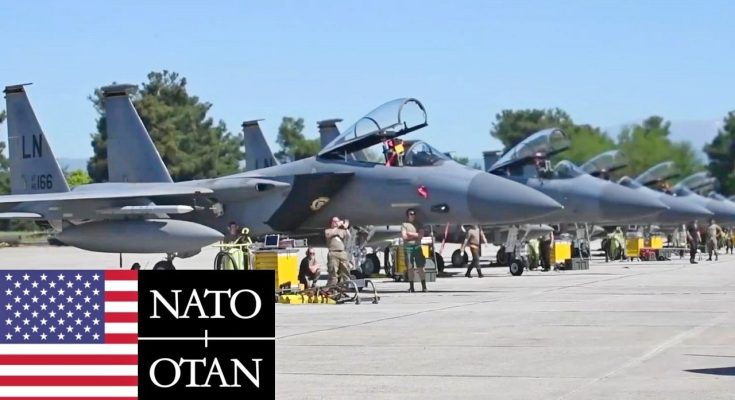USAF, NATO F-15 Eagle Fighters During Large-Scale Joint Military Exercises in Greece
In recent years, the U.S. Air Force (USAF) and NATO have strengthened their military cooperation through large-scale joint exercises, with one of the most significant being held in Greece. These exercises, designed to enhance the interoperability and readiness of allied forces, often feature some of the most advanced and capable aircraft in the world. Among these aircraft is the F-15 Eagle, a legendary air superiority fighter that plays a crucial role in ensuring air dominance during military operations. The participation of USAF F-15 Eagles in these exercises demonstrates the powerful partnership between the U.S. and NATO forces and highlights the ongoing need for readiness in the face of global security challenges.
F-15 Eagle: A Proven Air Superiority Fighter
The McDonnell Douglas F-15 Eagle has been a mainstay of the U.S. Air Force since the 1970s, renowned for its unmatched air superiority capabilities. Known for its speed, agility, and firepower, the F-15 has been a vital asset in ensuring control of the skies. The aircraft’s versatility allows it to perform multiple missions, including air-to-air combat, air-to-ground strikes, and long-range intercepts.
The F-15’s impressive avionics suite, coupled with its advanced radar and weapons systems, allows it to detect, track, and engage adversary aircraft at extended ranges. Its two-engine design provides exceptional thrust-to-weight ratio, allowing for superior maneuverability and speed, essential attributes for air superiority roles. Over the years, the F-15 has undergone numerous upgrades, ensuring that it remains relevant in modern combat scenarios. This makes it a reliable and formidable asset in joint exercises, where it works alongside allied forces to simulate and practice complex combat operations.
Large-Scale Joint Exercises in Greece
Greece, strategically located in southeastern Europe, has become an important venue for NATO’s joint military exercises. The Greek airspace and its proximity to critical regions such as the Eastern Mediterranean and the Balkans make it an ideal setting for large-scale training operations. These exercises aim to enhance coordination and integration between NATO and U.S. forces, ensuring that allied air forces can operate seamlessly together in any future conflict.
During these joint exercises, USAF F-15 Eagles are often pitted against advanced enemy aircraft in simulated air combat scenarios. Working alongside other NATO fighters, such as the F-16 Fighting Falcon and the Eurofighter Typhoon, the F-15s engage in various combat missions, ranging from dogfighting and combat air patrols to more complex scenarios involving multi-aircraft coordination.
One of the key objectives of these exercises is to refine tactics, techniques, and procedures (TTPs) for air superiority missions. For example, the USAF and NATO pilots practice formation flying, target identification, and engagement protocols. These exercises also involve large-scale combat simulations that test the ability to manage airspace, coordinate air-to-air and air-to-ground strikes, and react to evolving threats in real-time.
Enhancing Interoperability
A critical component of these exercises is improving interoperability between the various NATO forces. Given the diverse aircraft and tactics employed by NATO members, joint exercises like those in Greece allow participating nations to refine their procedures for working together in high-pressure situations. For the F-15 pilots, this means understanding how to operate in conjunction with other NATO aircraft, sharing intelligence, coordinating attack runs, and supporting one another during combat operations.
Interoperability also extends beyond the cockpit. Ground personnel from various nations work side by side, learning how to service and maintain different aircraft, exchange logistical support, and adapt to diverse military procedures. This enhanced cooperation ensures that NATO forces are prepared for rapid deployment and coordinated responses to any crises, whether in Europe, the Middle East, or beyond.
Strategic Importance of the Greece Exercises
The importance of holding large-scale exercises in Greece cannot be overstated. The location provides a strategic vantage point for NATO forces to project power across the Mediterranean and Eastern Europe, regions that have witnessed increasing geopolitical tensions. The exercises also demonstrate NATO’s commitment to maintaining air superiority in these critical areas, especially in the face of evolving threats from Russia and other regional actors.
The presence of USAF F-15 Eagles, with their proven capability to counter advanced enemy aircraft and provide a dominant air presence, signals NATO’s ability to respond to any challenge in the region. These exercises serve as a reminder that the alliance remains capable of defending its airspace, projecting force, and ensuring peace and stability in Europe.
Conclusion
The participation of USAF F-15 Eagles in large-scale joint military exercises in Greece underscores the growing importance of NATO’s air superiority capabilities. These exercises not only enhance the operational readiness of allied forces but also improve the integration and coordination between different military units. The F-15, with its advanced technology and exceptional performance, continues to be a critical asset in these exercises, ensuring that NATO remains ready to confront any challenge that may arise. As global security dynamics continue to evolve, such exercises ensure that NATO forces maintain their edge in air combat and their ability to respond rapidly and decisively to any threats.



